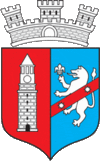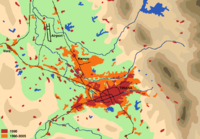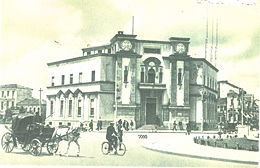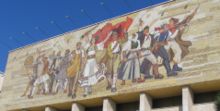Tirana
2008/9 Schools Wikipedia Selection. Related subjects: Europe; European Cities
| Tirana Tiranë |
|||
| Scanderbeg Square by night | |||
|
|||
| Location of Tirana in Albania | |||
| Coordinates: | |||
|---|---|---|---|
| Country | |||
| County | Tiranë County | ||
| District | Tiranë District | ||
| Founded | 1614 | ||
| Government | |||
| - Mayor | Edi Rama ( PS) | ||
| Area | |||
| - Total | 41.8 km² (16.1 sq mi) | ||
| Elevation | 110 m (361 ft) | ||
| Population (2007) | |||
| - City | 607,467 | ||
| Time zone | CET ( UTC+1) | ||
| - Summer ( DST) | CEST ( UTC+2) | ||
| Postal code | 1001 to 1054 | ||
| Area code(s) | 4 | ||
| Car Plates | TR | ||
| Website: http://www.tirana.gov.al | |||
Tirana ( Albanian: Tiranë or Tirana) is the capital and largest city of the Republic of Albania. It was founded in 1614 by Sulejman Pasha and became Albania's capital city in 1920.
The City of Tirana is located at (41.33°N, 19.82°E) in Tirana District, Tirana County and is bordered to the north by the hills of Kamza, east by Mount Dajt, west by the hills of Vaqarr and Yzberisht, and south by the hills of Krrabë and Sauk. Tirana's average altitude is 110 meters (361 ft) above sea level and lies on the Ishëm River, about 20 miles (32 km) inland. There are two main rivers that run through the city: the Lana and the Tirana River. The city also contains a total of four lakes: Tirana Lake, Kodër-Kamëz Lake, Farka Lake, and Tufina Lake.
Population
In 2007, Tirana's population was officially at 607,467.
In 1703, Tirana had about 4,000 inhabitants and by 1820 there were approximately 12,000. The city's population rose to 25,079 by 1930 and near 70,000 in 1945, despite the intervening years of foreign occupation and war. During the 1950s, Tirana experienced rapid industrial growth, and the population increased to about 137,000 by 1960.
After the end of communist rule in 1991, Tirana experienced its fastest population growth as people from rural areas moved to the capital in finding a better life. In 1990, Tirana had 300,000 inhabitants, but the large-scale influx since then from other parts of the country has increased the population to well over 800,000.
Etymology
There are a number of theories concerning the origin of the name:
- from the word "Theranda", used by Greek and Latin sources to refer to the area, after the local term "te ranat", meaning fallen material, in reference to the composition of the terrain from hard earth carried down by water from the nearby mountains.
- from "Tirkan", the name used by the sixth century Byzantine historian Procopius to refer to a castle, first built in the first century BC, on Mount Dajti, the ruins of which still stand.
- from "tyros", the old Greek word for dairy, reflecting the fact that local shepherds gathered here to trade dairy products.
- from "Tiras" whom the ancient Thracians worshipped. They named many places in the Thracian area after this god.
- an often-repeated explanation, though ultimately fallacious, is that Tirana was so named by Sulejman Pasha after the Persian capital Tehran, to mark his conquest of Persia in the 17th century. This seems to be contradicted by the use of Tirana's name in its current form (il borgo di Tirana) appearing in a Venetian document of 1572.
- When Sulejman Pasha was at the location of what would become Tirana, he came across an elderly woman and asked her what she was doing. She replied, "Po tir an" (spinning silk).
- from regional dialect of central Albania, the first version for Tiranë origin name is true, but not referring to fallen material, but to peoples. If we analyze the demographic movements of the population of the surrounding are, we will observe that the first inhabitants of the town (village at that time) are from the mountains around. In regional dialect always the displaced peoples from the mountains to the plain are called “Të rânë. That means peoples who have come down from the mountains. Still today the pronunciation “Tiranë” in the regional dialect is “Tirônë”.
- there is another theory for the origin of name that is "tri ane". It means the three ways because the most important commercial ways, the ones that come from Shkodër, Berat and Durrës, of the time passed through the modern centre of Tirana. That's why Sulejman Pasha built a moschea, a popular Turkish bathroom and a kind of hotel "han" for the caravans to rest.
History
The area now occupied by the city of Tirana has been populated since Neolithic times, as evidenced by various remains discovered there. A castle, possibly called Tirkan, was built by Emperor Justinian in 520 AD and restored by Ahmed Pasha Toptani in the 18th century. The area had no especial importance in Illyrian and Classical times. There were medieval settlements in the area at Preza, Ndroq, Lalmi and Petrela Castle. In 1418, Marin Barleti, an Albanian Catholic priest and scholar, the first to write a history of Albania, referred to "Plenum Tyrenae", a small village. There are references to "Tirana e Madhe" and "Tirana e Vogël" (Greater and Lesser Tirana).
The records of the first land registrations under the Ottomans in 1431-32 show that Tirana consisted of 60 inhabited areas, with nearly 1,000 houses and 7,300 inhabitants. The 1583 registration records that Tirana had 110 inhabited areas, with 2,900 houses and 20,000 inhabitants.
Süleiman Pasha Mulleti (or Sulejman Pasha), a local ruler, established the Ottoman town in 1614 with a mosque, a commercial centre and a hammam (Turkish sauna). The town was located along caravan routes and grew rapidly in importance until the early 19th century. During this period, the mosque in the centre of Tirana, the Et'hem Bey Mosque designed by Molla Bey of Petrela, began to be constructed. It employed the best artisans in the country and was completed in 1821 by Molla's son, who was also Sulejman Pasha's grand-nephew. After 1816, Tirana languished under the control of the Toptani family of Kruja.
On February 8, 1920, Tirana was chosen as the temporary capital of Albania, which had acquired independence in 1912, by the Congress of Lushnja. The city retained that status permanently on December 31, 1925. Since 1925, when they were banned in Turkey, the Bektashis, an order of dervishes who take their name from Haji Bektash, a Sufi saint of the 13th and 14th centuries, made Tirana their primary settlement. The first regulatory plan of the city was compiled in 1923 by Estef Frashëri. Durrësi Street was opened in 1922 and was called Nana Mbretneshë (Mother Queen). Many houses and surrounding properties were demolished to make way for it. The existing parliamentary building was raised in 1924 and first served as a club for officers. It was there, in September 1928, that King Zog I was crowned King.
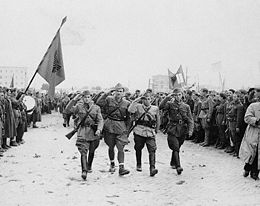
The centre of Tirana was the project of Florestano de Fausto and Armando Brasini, well known architects of the Mussolini period in Italy. The Palace of Brigades, the government ministry buildings, the National Bank, today's Municipality, and the University buildings are their work. Dëshmorët e Kombit (National Martyrs) Boulevard was built in 1930 and named "Zogu I Boulevard." In the communist period, the part from Skënderbeg Square up to the train station was named "Stalin Boulevard". Tirana was occupied until 1944, first by the Italians, and then by the Germans. The Nazis eventually withdrew and the communists seized power.
In the following decades, a number of buildings with cultural significance were demolished to make way for the formation of today's Scanderbeg Square. In the place of today's Hotel Tirana International building used to be established the Autocephaleus Orthodox Church, one the biggest in the country. Near the grounds of today's Opera house at the Palace of Culture used to be the Old Bazaar (Pazari i Vjetër), hence the name of Tirana's market, Pazari i Ri (New Bazaar). The National Museum is built on the grounds of the former building of the Municipality of Tirana. The building was detonated and the Museum was completed in 1982. The first structure which used to house the Parliament of Albania in King Zog's period was later transformed into a children's theatre, the Dolls' Theatre (Teatri i Kukullave).
A series of explosion at an army depot near Tirana March 15, 2008 killed at least fifteen and injured 243 people, including many children, and damaged the city's nearby International Airport Nënë Tereza.
Health
The largest hospital in Tirana is called Mother Theresa Hospital (Spitali Nënë Tereza), which is associated with University of Tirana, Faculty of Medicine. The Hospital is a 1,456 bed facility that offers comprehensive in patient tertiary care to over 12,000 patients annually. The hospital is currently undergoing major changes in infrastructure and equipment.
Climate
Tirana has a generally Mediterranean climate. The average temperature varies from a low of 5°C in January to a high of 31°C in July. The driest months are July and August, each with less than 1cm of precipitation on average, while the wettest months are October, November and December, averaging over 3cm each.
| Month | Jan | Feb | Mar | Apr | May | Jun | Jul | Aug | Sep | Oct | Nov | Dec | |
|---|---|---|---|---|---|---|---|---|---|---|---|---|---|
| Avg high (°C) | 12 | 13 | 14 | 18 | 21 | 25 | 28 | 28 | 25 | 22 | 16 | 13 | |
| Avg low (°C) | 5 | 6 | 8 | 11 | 15 | 19 | 21 | 21 | 18 | 14 | 12 | 7 | |
| Source: MSN Weather | |||||||||||||
Culture
Numerous cultural activities take place in Tirana. The National Theatre offers premiers of national and international creations of art. Painting exhibitions take place at the National Gallery and the Symphonic Orchestra of Albanian Radio and Television (RTSH) offers performances of renown world artists through out the year. The city has been a venue for the Tirana Biennale and Tirana Jazz Festival. Tirana is also home of many historical and cultural sites: the Castle or Fortress of Tirana (Kalaja e Tiranës) - the historical core of the capital - Kroi Church of Shëngjin (Kisha e Kroit të Shëngjinit), Preza Castle/Fortress (Kalaja e Prezës), Petrela Castle/Fortress (Kalaja e Petrelës), Tirana's Mosque of Et'hem Bej (Xhamia e Tiranës), the Centre of Tirana - as a monumental ansemble - Tabak's Bridge (Ura e Tabakëve), Kaplan Pasha's Grave (Varri i Kapllan Pashës) and the Clock Tower (Kulla e Sahatit). Tirana has 8 public libraries, one being the National Libray of Albania, 5 museum-houses and 56 cultural monuments. For more information, see Landmarks section below.
Districts
The two oldest neighbourhoods are Mujos and Pazari, located between the geographical centre and Elbasani Street on either side of the Lana River. In 2000, the centre of Tirana, from the central campus of Tirana University up to Skënderbeg Square was declared the place of Cultural Assembly, and given special claims to state protection. In the same year, the area began a process of restoration under the name ‘Return to Identity’. The area to the west of the university, adjacent to Saint Prokopi park, was formerly reserved for the occupation of important government and party officials. It remains a desirable residential area.
Economy
Tirana is Albania's major industrial centre. It has experienced rapid growth and established many new industries since the 1920s. The principal industries include agricultural products and machinery, textiles, pharmaceuticals, and metal products.
Tirana began to develop in the beginning of the 16th century, when a bazaar was established, and its craftsmen manufactured silk and cotton fabrics, leather, ceramics and iron, silver, and gold artifacts. Sited in a fertile plain, the Tirana area exported 2,600 barrels of olive oil and 14,000 packages of tobacco to Venice by 1769. In 1901, it had 140,000 olive trees, 400 oil mills, and 700 shops. Tirana is currently trying to develop a tourist industry, although this effort has been hampered by the lack of infrastructure and the perception of political instability in the region.
Education
Tirana hosts the University of Tirana, founded in 1957, and other governmental and social buildings such as the Albanian Institute of the Sciences, the Academy of Arts, the Agricultural University, the Military Academy, the Institute of the Ministry of Internal Affairs, the People's Assembly, and the High Court.
In addition to the public universities, Tirana is host to private academic institutions, such as University of New York, Tirana, Universiteti Marin Barleti, Epoka University, etc.
Environment
The city suffers from problems related to overpopulation, such as waste management, lack of running water and electricity as well as extremely high levels of air pollution from the 300,000 cars moving around the city. The problem is exacerbated by aging infrastructure. Despite the problems, Tirana has also experienced a very rapid growth in the construction of new buildings, especially in the suburbs, where many of the new neighbourhoods do not yet have street names. In recent years pollution has worsened as the number of cars has increased by several orders of magnitude. These are mostly older, diesel cars that pollute much more than the newer models in circulation elsewhere in Europe. Additionally, most of the fuel used in Albania contains larger amounts of sulphur and lead than that allowed in European Union countries. In recent years pollution from construction has become a major concern for the inhabitants of the city. Moreover, green spaces in densely populated areas are scarce. Another peril to the city comes from untreated solid waste.
Beginning in the year 2000, Tirana's Municipality has undertaken a massive campaign to return public space to the general public. The campaign "Return to Identity" included the transformation of Lana River banks, Rinia Park and others to their pre-1990 state. The overall infrastructure has improved as considerable number of roads have been reconstructed. Common spaces between apartment buildings have been targeted in bringing back green spaces and a vast number of illegal buildings have been demolished.
Saint Prokopi park, a vast forested park in the outskirts of the city, has some effect on absorbing CO2 emissions. Tirana is cleaned by governmental workers everyday, and trees have been planted around many sidewalks.
People
Below are some of most notable personalities born in Tirana:
- Edvin Murati
- Elsa Lila - singer
- Erjon Bogdani
- Essad Pasha
- Fatos Nano - former Prime Minister of Albania
- Inva Mula
- Leka, Crown Prince of Albania - son of King Zog I
- Rexhep Meidani - former President of Albania
- Saimir Kumbaro
Sports
Transport
National and international transport links have developed over recent years as demand has increased. Until recent years, overland connections through Greece and Montenegro have had various problems with bureaucracy or security. The following section is liable to change and is only indicative.
Bus
International coach services connect to Greece, via Korçë and then taxis to the border, to Serbia, and to Republic of Macedonia. Coach and minibus services run, according to demand, to the coast and northern and southern Albania from different locations in Tirana. Local transport within Tirana is by bus or taxi.
Rail
There are regular passenger services to Durrës and Pogradec, via Elbasan. The railway station is north of Skanderbeg Square, in Boulevard Zogu I. There are no international passenger services, although there is a freight-only railway through Shkodër to Montenegro (though this is currently disused).
Air
Tirana International Airport Nënë Tereza (Mother Theresa in Albanian), also known as Rinas Airport was recently reconstructed. It is located 25 kilometres north-west of the city, off the road to Durrës. Airlines using Rinas include Albanian Airlines. Flights run to Athens, New York, Rimini, Bari, Genoa, Rome, Bologna, Munich, Frankfurt, Istanbul, Vienna among other places.
Several foreign airlines also serve Rinas Airport: Alitalia (from Rome and Milan), British Airways (from London Gatwick Airport), Austrian Airlines (from Vienna), Adria Airways (Ljubljana), Jat Airways (Belgrade), Malev (Budapest), Olympic Airlines (Athens), Hemus Air ( Sofia) and Turkish Airlines (Istanbul). Lufthansa flights via Munich started on 1 May 2007. Each Monday, there is a direct flight from Tirana to J.F.K. Airport, New York, USA.
Sea
Tirana does not have a port of its own. However, the port city of Durrës is no more than half an hour away from the capital. Passenger ferries from Durrës sail to Trieste (Italy), Koper (Slovenia) and there is a fast catamaran service to Bari (Italy).
Landmarks
- Skanderbeg Square: the central hub of the city, named after the Albanian hero, Skanderbeg.
- Et'hem Bey Mosque: at the south east corner of Skanderbeg Square - begun in 1789 by Molla Bey and finished in 1821 by his son, Haxhi Et'hem Bey, great-grandson of Sulejman Pasha.
- The Clock Tower (the Kulla e Sahatit,) next to the Et'hem Bey Mosque, was started by Haxhi Et’hem Bej around 1821-22 and was finished with the help of the richest families of Tirana. Its installation was the work of the Tufina family. In 1928 the Albanian state bought a modern German clock and the tower was raised to a height of 35 metres. The clock was damaged during World War II and it was repaired in July 1946.
- Government buildings: at the south end of Skenderbeg Square
- National Museum: north side of Skenderbeg Square
- The headquarters of the Bektashi Sufi Order can be found in the eastern edge of the city.
- Roman Catholic Church of Saint Paul: completed in 2001, the largest church in Tirana.
- Orthodox Church of St Prokop was built in 1780.
- Roman Catholic Church of Saint Maria was built in 1865, paid for by Emperor Franz Joseph of Austria.
- The Tabakëve and Terzive bridges (respectively in front of the Parliament building and on Elbasani Street) date from the beginning of the 20th century.
- The mosque that is also the tomb of Kapllan Hysa, near the monument to Ushtari i Panjohur (‘the unknown soldier’) was built in 1816.
- The National Library was established in 1922, with 5000 volumes.
- The Fortress or Castle of Petrela, 12 kilometres from Tirana, dates from the fourth century BC. It took its current form in the 13th century, under the rule of Topiaj, and later became the property of the Kastriotis.
- The Palace of Culture (Pallati i Kulturës), where the Theatre of Opera and Ballet and the National Library stand, was completed in 1963 on the site of the former Trade of Tirana building, with the first brick being placed by Soviet president Nikita Khruschev in 1959.
- The monument to Skënderbeu, raised in 1968, is the work of Odhise Paskali in collaboration with Andrea Mana and Janaq Paço. It commemorated the 500th anniversary of the death of the national hero.
- The monument to Mother Albania, 12 metres high, was inaugurated in the Dëshmoret e Kombit cemetery in 1971.
- The Academy of Sciences building was completed in April 1972.
- The Gallery of Figurative Arts was created in 1976 and includes around 3200 works by Albanian and foreign artists.
- The International Cultural Centre, formerly the Enver Hoxha Museum, was inaugurated in 1988. Popularly referred to as ‘the Pyramid’, it was designed by a group of architects under the direction of the dictator's daughter, Pranvera Hoxha, and her husband Klement Kolaneci.
- The National Historical Museum was built in 1981. The ornamental mosaic on its facade is called "The Albanians".
- The presidential palace, Tirana, also known as the Palace of Brigades, was built by King Zog as his residence in the 1930s.
Twin or partner cities
 Paris, France
Paris, France Moscow, Russia
Moscow, Russia Marseille, France
Marseille, France Ankara, Turkey
Ankara, Turkey Bursa, Turkey
Bursa, Turkey Sarajevo, Bosnia and Herzegovina
Sarajevo, Bosnia and Herzegovina Rome, Italy
Rome, Italy Florence, Italy
Florence, Italy Turin, Italy
Turin, Italy Genoa, Italy
Genoa, Italy Cobourg, Canada
Cobourg, Canada Seoul, South Korea
Seoul, South Korea Zaragoza, Spain
Zaragoza, Spain Sofia, Bulgaria
Sofia, Bulgaria Bucharest, Romania
Bucharest, Romania Brussels, Belgium
Brussels, Belgium Stockholm, Sweden
Stockholm, Sweden Kiev, Ukraine
Kiev, Ukraine Vilnius, Lithuania
Vilnius, Lithuania Longanikos, Greece
Longanikos, Greece


